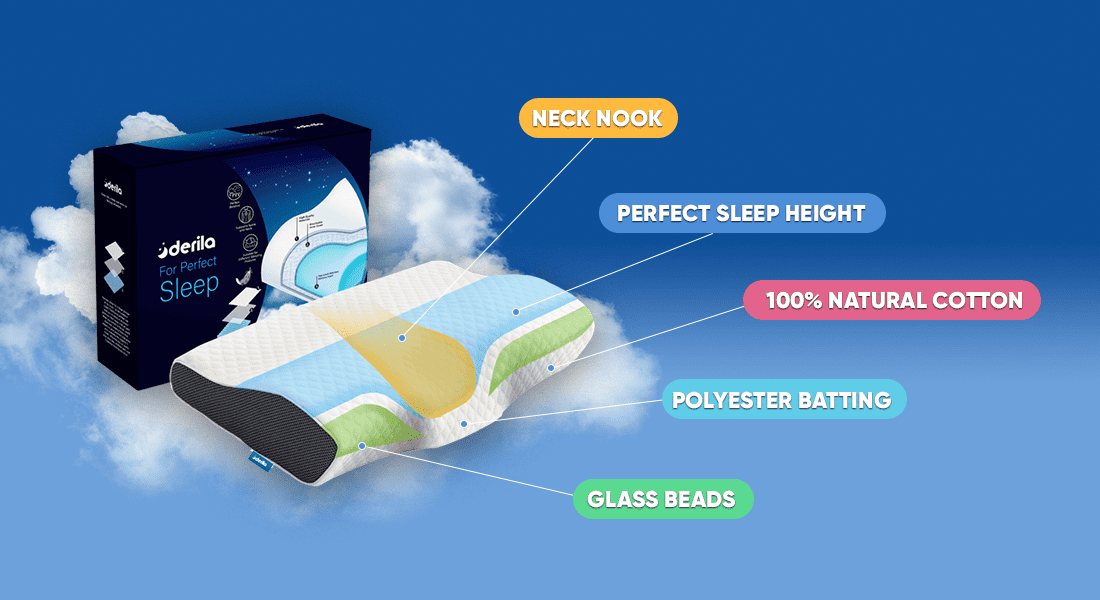Sleeping on one side night after night can have some noticeable effects on your face. First off, the constant pressure can lead to wrinkles, especially the lines that run from your nose to the corners of your mouth, called nasolabial folds. Secondly, even though no one’s face is perfectly symmetrical, consistently sleeping on one side can accentuate these natural differences, making them more visible due to the uneven pressure.
Keep in mind, though, that we don’t stay in one position all night. Most of us toss and turn, so the pressure on our faces tends to even out. Also, genetics play a significant role; some people are just more prone to wrinkles or facial asymmetry than others.
If you’re worried about the effects of side sleeping on your face, there are effective solutions to prevent and correct these issues.
Table of Contents:
How Sleeping on One Side Affects Facial Appearance
Sleeping on one side night after night affects your face due to different factors.. Understanding why it happens helps address the issue and fix it if needed.
Understanding Facial Asymmetry and Compression
Sleeping on one side consistently eventually leads to changes in facial symmetry. This is because the constant pressure of your face against the pillow compresses the skin and underlying tissues, also weakening collagen and elastin with a flattening effect. An Aesthetic Surgery Journal publication proves that when you sleep on your side or stomach, your face gets pressed and pushed in certain ways. As a result, the side you sleep on may appear flatter and develop more pronounced wrinkles compared to the other side.
Exploring the Effects on Your Face Skin Health
Side sleeping affects your skin health in several ways. The skin stays in constant contact with the pillowcase, which irritates it. The rubbing action can lead to microscopic damage, resulting in breakouts. An unwashed pillowcase worsens your acne, so it is highly recommended to wash it frequently.
Side sleeping presses your face against the pillowcase, increasing moisture loss through friction, and contributing to a dehydrated and dull appearance. Furthermore, the pressure on your face impedes lymphatic drainage, a system responsible for removing waste products and toxins from the skin. Blocked lymphatic drainage causes puffiness, particularly around the eyes and cheeks.
Consequences of Restricted Blood Flow and Collagen Breakdown
When you sleep on your side, pressure points are created where your face comes into contact with the pillow. These pressure points compress blood vessels and restrict blood flow to specific regions. This restricted blood flow reduces the delivery of oxygen and essential nutrients to the skin cells, hindering their ability to function optimally. You can learn how to increase blood circulation in your face to address it.
If you have hypertension (high blood pressure), your blood vessels get damaged over time. The increased pressure strains the vessel walls, causing them to thicken, narrow, and lose elasticity.
Chronic sleep deprivation can significantly impact your body’s blood flow. When you don’t get enough quality sleep, your blood vessels constrict, hindering the delivery of essential oxygen and nutrients to tissues. This lack of restorative sleep also affects the endothelium, the inner lining of your blood vessels. Disrupted sleep patterns impair endothelial function, leading to inflammation and reduced vasodilation. Observational studies, such as this one, consistently link short sleep duration with an increased risk of hypertension.
Both deprived sleep and hypertension disrupt the delicate balance of blood flow, potentially affecting facial symmetry on the side you consistently sleep on. Additionally, the prolonged pressure on your face during side sleeping contributes to collagen breakdown, accelerating the development of wrinkles and loss of skin elasticity. Therefore, prioritizing quality sleep and managing blood pressure are crucial for preserving skin integrity.
Preventing and Correcting Side-Sleeping Facial Impact
While completely eliminating side sleeping might not be realistic, there are ways to minimize its impact on your face. Here are a few tips:
Choosing the Right Pillow

Derila pillow features soft memory foam and a silky cover, designed to protect your facial skin and reduce pressure on your face. It offers excellent head and neck support, promoting correct posture no matter which sleeping position you prefer.
Check Price >>The type of pillow you use can significantly impact how your face ages during sleep. Here are some key considerations:
Material: Opt for a pillowcase made of silk or satin. These materials have a smooth surface that reduces friction against your skin, minimizing wrinkles and irritation. Cotton pillowcases, while breathable, can cause more friction and potentially lead to sleep lines.
Size: Choosing the right size pillow is also important. A pillow that’s too big can force your head and neck into an unnatural position, potentially leading to wrinkles and discomfort. Conversely, a pillow that’s too small won’t provide adequate support, causing your head to tilt at an angle and compress one side of your face.
Support: A supportive pillow that cradles your head and neck in proper alignment is crucial. Consider ergonomic pillows designed to maintain the natural curvature of your spine and prevent your face from smushing against the surface. Our top recommendation is the Derila pillow, and you can read all about its features and benefits in this Derila cervical memory foam pillow review.
Adopting Protective Face Skincare Routines
A good nighttime skincare routine can help strengthen your skin’s barrier, maintain hydration, and promote rejuvenation while you sleep. Here’s what to consider:
Cleansing: Before bed, cleanse your face to remove makeup, dirt, and oil buildup that can clog pores and irritate the skin.
Moisturizing: Apply a good quality moisturizer suitable for your skin type. Look for ingredients like hyaluronic acid, ceramides, and antioxidants to hydrate, plump, and protect the skin from free radical damage.
Retinol: Consider incorporating a retinol product into your nighttime routine a few times a week. Retinol is a powerful ingredient that stimulates collagen production and cell turnover, helping to reduce the appearance of wrinkles and promote firmer skin.
Effective Use of Sleep Lines Prevention Products
Several products can be used alongside your skincare routine to further minimize the appearance of sleep lines:
Overnight Facial Masks: These masks deliver a concentrated dose of hydrating, nourishing, and wrinkle-fighting ingredients while you sleep. Look for masks with ingredients like hyaluronic acid, collagen, and peptides for optimal results.
Anti-Wrinkle Pillows: These specialized pillows often have built-in indentations or cutouts designed to prevent your face from creasing against the surface during sleep. While their effectiveness can vary, they may offer some additional support for those concerned about sleep lines.
Silicone Patches: These adhesive patches are applied directly to areas prone to sleep wrinkles, such as the corners of your eyes and mouth. The patches create a physical barrier that helps prevent the skin from creasing during sleep.
Incorporating Mewing Exercises
Mewing is a facial posture technique that involves placing your tongue on the roof of your mouth and gently pressing upwards. The practice can help improve facial muscle tone, reduce tension, and potentially promote a more symmetrical appearance. Here is a quick overview to give you an idea.
Gently close your mouth and keep your lips together without strain.
Place the tip of your tongue just behind your upper front teeth.
Press your entire tongue flat against the roof of your mouth, including the back third.
Maintain a light but consistent pressure. You should feel a slight engagement in your jaw muscles.
Breathe through your nose while holding this position.
Mewing is meant to be a gentle exercise. Hold the position for 30 seconds to a minute, then relax your tongue. Repeat this exercise several times throughout the day.
Get a Facial Massage
A professional facial massage can be a relaxing and potentially beneficial way to address the effects of side sleeping. Facial massage techniques can help to:
Improve circulation and lymphatic drainage, reducing puffiness and promoting a more youthful appearance.
Relieve facial muscle tension, which can contribute to wrinkles and asymmetry.
Promote collagen production, leading to firmer and more elastic skin.
While a professional facial massage can be a luxurious treat, there are also self-massage techniques you can learn to incorporate into your nighttime routine.
By combining these strategies, you can minimize the impact of side sleeping on your face and promote a more youthful and symmetrical appearance. Being consistent matters. The more you prioritize these practices, the better the results you’ll likely see over time.
Adjusting Sleep Habits for Symmetrical Beauty
Achieving a balanced and symmetrical face is a key aspect of beauty. While genetics play a role, your sleep habits can significantly impact facial symmetry over time. Here are some tips to adjust your sleep for a more symmetrical and youthful appearance:
Alternating Side Sleeping Positions
If side sleeping is your go-to position, try to alternate sides throughout the night. This helps distribute pressure on your face more evenly, reducing the risk of one side becoming flatter or developing more wrinkles. Avoid sleeping with T-rex arms, a position where you prop yourself up on one elbow, as this can put uneven pressure on your face and neck.
Back Sleeping: The Ideal Position
Sleeping on your back is considered the best position for preventing facial asymmetry and wrinkles. While it may feel unnatural at first for side sleepers, there are ways to ease into it. Try placing a rolled-up towel or small pillow under your knees to provide support and keep your spine aligned. Additionally, practice sleeping on your back with your arms relaxed at your sides to avoid putting pressure on your face.
Utilizing Supportive Sleep Accessories
Several sleep accessories can help you achieve a more symmetrical sleep posture.
Contoured pillows: These pillows have a specific shape designed to cradle your head and neck in proper alignment, minimizing pressure on your face.
Body pillows: A body pillow can help you maintain a back sleeping position by providing a sense of security and preventing you from rolling onto your side.
Low loft pillows: If you find stomach sleeping unavoidable, consider using low loft pillows to minimize neck strain and prevent your face from smushing against the mattress.
When to Consult a Professional
While the tips mentioned can help minimize the impact of side sleeping, there may be situations where seeking professional guidance is advisable. Consider consulting a dermatologist or esthetician if:
You experience persistent skin concerns like acne breakouts or irritation despite implementing a consistent skincare routine.
You notice significant facial asymmetry that bothers you and doesn’t seem to improve with lifestyle changes.
You’re interested in exploring professional treatments like dermal fillers or Botox to address wrinkles or asymmetry.
A dermatologist can diagnose any underlying skin conditions and recommend targeted treatment options. An esthetician can provide advanced skincare regimens and techniques to address specific concerns. Early intervention is often key, so don’t hesitate to seek professional advice if you have any worries about your skin or facial symmetry.
Summing Up Facial Asymmetry Concerns Due to Side Sleeping
While side sleeping is a natural position for many, it can lead to unwanted wrinkles, puffiness, and even facial asymmetry over time. This guide has explored various strategies to combat these side effects, from choosing the right pillow to incorporating facial exercises and sleep accessories.
Remember, sticking to these practices is crucial! By focusing on good sleep habits and making a few changes, you can help your skin stay healthier and look more youthful and balanced.
